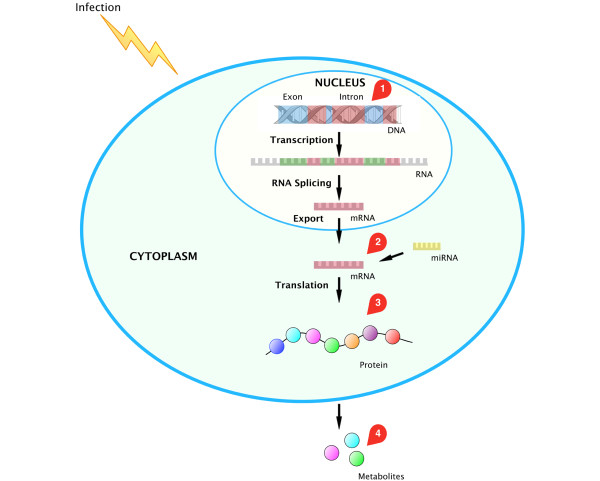Figure 1.

Central workflow from gene activation to protein metabolites in response to insults such as infection. Numbers denote different targets for diagnostic approaches: 1, epigenomics (methylation variable positions) and genomics (SNPs); 2, transcriptomics (mRNA and miRNA); 3, proteomics; and 4, metabolomics. The central workflow in molecular biology is that, upon gene activation, DNA is transcribed into mRNA and is then translated into proteins. DNA expresses its information by a process called transcription. In this process, segments of the DNA sequence are used as templates for the synthesis of shorter molecules of the closely related molecule RNA. This molecule consists of sequences of nucleotides faithfully representing a part of the cells genetic information. The transcription results in pre-mRNA, which through an additional splicing process produces a mature single strand of complementary RNA, mRNA. mRNA functions as an intermediate in the transfer of genetic information, mainly guiding the synthesis of proteins according to the genetic instructions stored in the DNA. Once mRNA is produced and transported out of the nucleus, the information present in the mRNA is used to synthesize a protein by the process called translation. This protein synthesis is performed in the cytosol of the cell by the ribosome, the workhorse of protein biosynthesis. mRNA is pulled through the ribosome and the nucleotide sequence is translated into an amino acid sequence, adding each amino acid to a growing polypeptide chain that constitutes a protein. miRNA can alter this step by binding to the mRNA, resulting in additional regulation of the mRNA expression. miRNA is complementary to a part of one or more mRNAs. While degradation of miRNA-targeted mRNA is well documented, whether or not translational repression is accomplished through mRNA degradation, translation inhibition or a combination of the two is hotly debated. After the polypeptide chain is produced, it folds up into its unique three-dimensional conformation, which is necessary in order to be useful to the cell. The result is the final product, a mature protein that is released into the bloodstream where it will have its effects [98].
